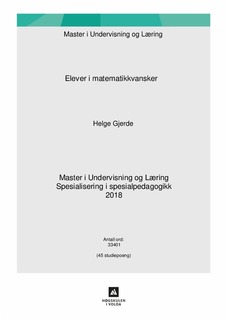| dc.contributor.author | Gjerde, Helge | |
| dc.date.accessioned | 2018-08-23T10:10:38Z | |
| dc.date.available | 2018-08-23T10:10:38Z | |
| dc.date.issued | 2018 | |
| dc.identifier.uri | http://hdl.handle.net/11250/2559039 | |
| dc.description.abstract | Denne oppgaven omhandler elever som er i matematikkvansker. Målet med studien er å finne ut hvordan læreren kartlegger elever som er i matematikkvansker og hvilke tiltak han vurderer med hensyn til eleven sine læringsforutsetninger, matematikkens innhold og undervisningsform. Elevene jeg ønsker å få vite mer om er de som klarer seg bra i andre fag, men som sliter spesifikt i matematikk. Dette er elever som ikke har fått noen diagnose eller får spesialundervisning, og som får sin undervisning i klasserommet. Disse elevene står i fare for å danne seg en kvalitativt dårligere matematikkunnskap enn det som er forventet på det aktuelle årstrinn. For å finne ut mer om dette har jeg stilt følgende spørsmål: «Hvordan kartlegges elever som er i matematikkvansker og hvilke tiltak vurderer læreren med hensyn til elevens læringsforutsetninger, matematikkens innhold og undervisningsform?» Jeg har brukt en kvalitativ forskningsmetode i denne studien, med semistrukturert intervju som metode. Tre lærere på mellomtrinnet har blitt intervjuet individuelt, alle tre trives med å undervise i faget og de har godkjent matematikkutdanning. Kvalitative data i funnene mine danner grunnlag for analyse og drøfting, sett i lys av relevant forskning og teori omkring matematikkvansker. Resultatet av studien viser at informantene i stor grad kartlegger elever i matematikkvansker gjennom statisk kartlegging, som for eksempel ukesluttprøver eller halvårsprøver. De kjenner i mindre grad til dynamiske kartleggingsverktøy som kan hjelpe dem å analysere og nyansere årsaker til matematikkvansker. Studien viser videre at de har god kjennskap til mange av læringsforutsetningene til elevene, de forsøker å tilpasse lærestoffet til de forutsetninger eleven i vansker har. Samtidig signaliserer de at hensynet til at eleven skal videre i sitt utdanningsløp, bidrar til at noen av enkeltfaktorene i elevens læringsforutsetninger får mindre oppmerksomhet. De trekker frem faktorer som for eksempel å la elevene arbeide mer med læringsstrategier eller at elevene får diskutere og samtale mer omkring matematiske problem. De peker også på at læreboken i for stor grad får styre innholdet og formen på matematikkundervisningen deres. For å endre dette har de ønske om mer fagdidaktisk kunnskap for å kunne hjelpe elever de erfarer er i matematikkvansker. | nb_NO |
| dc.description.abstract | Summary
This study discusses students that have learning difficulties in mathematics. The goal of the study is to find out how teachers map the needs of the students that are having problems in mathematics and what measures he or she will evaluate with regards to their students difficulties, the level of mathematics being studied and the form the education will take. The students that will be examined are those that perform well in other subjects but are having problems specifically with mathematics. These are students that have no diagnosed learning difficulties or special education and whose education is carried out in the classroom. These are students that have developed an qualitatively weaker mathematical ability than that which is expected for their school grade. In order to find out more around these issues the following questions have been asked: «How are the students with problems in mathematics mapped and what measures has the teacher considered in accordance with the learning abilities and needs of the students, the content of the mathematics and the teaching method?» A qualitative research has been used in this study, with semi-structured interviews as the method of gathering information. Three teachers in middle school have been interviewed individually, all three teachers enjoy teaching the subject and have approved qualifications to teach mathematics. The qualitative data collected, forms the basis of analysis and discussion in conjuction with relevant theories surrounding learning difficulties in mathematics. The results of this study show that the interview subjects mainly use static mapping to measure the students who are struggling with mathematics as a way of evaluating their needs, an example of the tools used are weekly testing or biannual testing. The teachers are vaguely aware of dynamic evaluation tools which can be used to analyse the nuances surround mathematical learning difficulties. This study also shows that the teachers have a good understanding of the learning expectations of the students and they try to adapt the material used to the needs and expectations of the struggling students. Additionally, the teachers have revealed that the futher education of the students has resulted certain areas that the students are having difficulty with, being given less attention. They also explained that the content of the course books have decided much of the areas of focus in the students education. In order to change this the teachers expressed a desire for greater subject knowledge in order to help those that they experience are having problems in mathematics. | nb_NO |
| dc.language.iso | nob | nb_NO |
| dc.publisher | Høgskulen i Volda | |
| dc.title | Elever i matematikkvansker | nb_NO |
| dc.type | Master thesis | nb_NO |
| dc.subject.nsi | VDP::Matematikk og Naturvitenskap: 400::Matematikk: 410 | |
| dc.source.pagenumber | 89 | nb_NO |
| cristin.fulltext | | |
